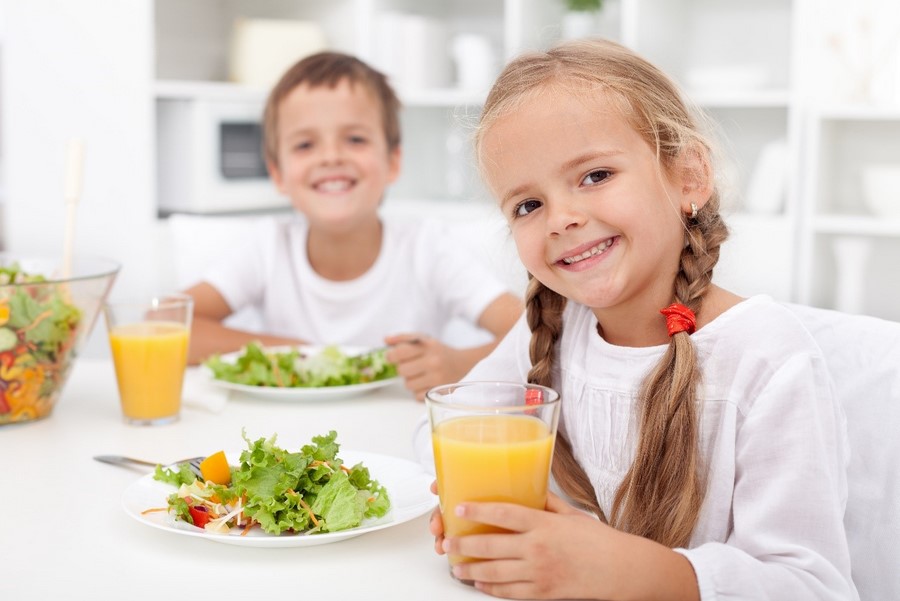How to Help Kids Build a Positive Relationship with Food
Food: it’s a simple word, but it has many different overtones. Many of us get a lot of pleasure from eating foods we enjoy. Others of us have a difficult relationship with food, such as disordered eating behaviours or mealtime challenges for children. These scenarios show that eating is more than just getting the nutrition we need to fuel our minds and bodies.
However, kids do need a healthy, balanced diet to power healthy growth and development. You can support your child to develop lifelong healthy eating habits by helping them build a positive relationship with food.
Why it’s important to have a positive relationship with food
Healthy eating habits support not only physical growth but also mental and emotional wellbeing. Research has shown that early childhood is a key time for building food preferences and dietary habits.ⁱ Encouraging children to have a healthy attitude towards food can help them develop behaviours that support lifelong good health.
This can sometimes be more difficult if your child has a disability or developmental delay. For example, your child may have food allergies or intolerances that limit which foods they can eat. Children with autism can have sensory sensitivities that make it difficult for them to eat certain foods.
Children with a disability are also at higher risk of developing unhealthy eating patterns than their peers. For example, kids aged 2 and over with disability are less likely than their peers to eat the recommended servings of fruit and vegetables and more likely to consume sugar-sweetened drinks each dayⁱⁱ
However, it may be easier than you think to help your child create healthy eating patterns. Taking some simple steps can go a long way towards fostering a positive relationship with food.
How to help children have a positive relationship with food
Here are 10 ways you can help your child build healthy, positive associations with food and eating.
1. Offer a wide variety of healthy foods
Aim to include a wide variety of vegetables, fruits, whole grains, and protein sources in your child’s meals. See the Australian Dietary Guidelines for more information about healthy eating for infants, children and teenagers.
If your child rejects a food initially, don’t give up. Simply clear it away and offer it again another time. It can take several goes before a child will try a new food. Being patient and persevering will give your child the best chance of developing a liking for many different healthy foods.
2. Aim to make food look appealing
You don’t have to plate up beautiful food that looks like it came from a chef’s kitchen, but you can do small things to help food look appetising. For example, you could make a face out of cut vegetables or serve up sliced wedges of different coloured fruits. Even what you serve food on can make a difference. If your child has a favourite bowl or plate, for example, use it to serve up new foods.
3. Make mealtimes fun
Try to create a positive and stress-free environment during mealtimes. Aim to eat at about the same time each day if you can and to have at least one meal together as a family. You might like to get everyone to leave their devices off the table and just enjoy spending time together.
You can encourage kids to try new foods by making it look appealing.
4. Involve your child
Getting kids involved in meal planning, grocery shopping and food preparation helps them develop a sense of ownership and curiosity about food. It also gives you an opportunity to talk about healthy eating. For example, you could explain how different foods provide what their bodies need to be healthy.
Depending on their age, you could get your kids to:
- Depending on their age, you could get your kids to:
- set the table
- mash vegetables or mix batters
- measure out dry and liquid ingredients
- make their own school lunch
- be in charge of making one meal per week.
5. Reinforce positive behaviours
Praising your child’s efforts to try new foods or make healthier choices can go a long way towards building positive eating habits. For example, you could say, “It’s great that you tried the cherry tomatoes. I really like the way you’re willing to give new things a go.”
6. Teach them to listen to their bodies
Our bodies have inbuilt signals that tell us when we’re hungry and when we’ve had enough to eat. Rather than pushing children to eat all the food on their plate, encourage them to take notice of their hunger and fullness cues.
7. Avoid using food as a reward
It’s tempting to offer a treat (or withhold one) to influence a child’s behaviour. However, using food as a reward or punishment too often can create unhelpful feelings about food and encourage unhealthy eating habits. Instead, try using rewards that promote good health, such as a trip to the park or some extra time playing with friends.
8. Explore new foods together
Introduce your whole family to new flavours, textures, and cuisines. Be open-minded and adventurous when trying new foods. For example, you could:
- pick one new fruit or vegetable to try each week
- try cooking one new recipe each week
- explore foods from different cultures, such as Mexican, Italian or Japanese.
9. Focus on health
You want your child to think of food as the thing that gives them nutrients to stay healthy, not something they can use to manipulate their appearance. When you’re talking about eating, focus on the importance of food for promoting energy, growth, and overall health, rather than on looks or weight. Cultivate a mindset that values food as fuel for their bodies to thrive.
Teach your child that food is neither “good” nor “bad”. Help them understand that a balanced diet includes a variety of foods, and occasional treats are perfectly okay. Try to avoid labelling foods as “forbidden” or creating a sense of guilt or shame around eating.
10. Consider your own eating patterns
Children learn by watching and imitating their parents and caregivers. Do what you can to set a good example for them. Your own diet may not be perfect – nobody’s diet is! But making efforts to eat more healthily will show your kids that you value your health and are willing to take steps to improve it.
It’s also important to be aware of how you talk about food and your own body. Try to avoid using negative words or phrases to describe yourself.
Focus on talking about how food can give you energy and keep you healthy.
You can work together as a family to build healthy habits. Some ways you could do this include:
- adding one extra vegetable to your plate at dinner time
- swapping out less healthy food choices for healthier alternatives
- cutting out one soft drink per week and having water instead
- taking fruit for a snack when you go out
- trying healthier ways of cooking your food, such as grilling rather than frying.
To make lasting changes, it’s important to find what works for your family. Why not pick one thing to try each week and go from there?
Helping kids with disability build positive eating patterns
Children with a disability, developmental delay or medical condition often have special dietary needs. But it’s still very possible for them to develop healthy attitudes about food and eating. In fact, doing so will help give them the best chance of forming habits that promote good health – for life!- picky eating and problem feeding
- food allergies and intolerances
- failure to thrive (growth faltering, slow growth, or poor growth)
- weight management
- nutritional deficiencies
- mealtime challenges
- disordered eating.
At Active Ability, our paediatric dietitians focus on working with children who have feeding or dietary issues related to autism, intellectual disability, neurological conditions and mental health issues.
Through our early intervention services, we create individualised meal plans and offer personalised support to ensure your child’s diet meets their needs. We can also help you address any concerns about eating or mealtime behaviours. Remember, the food preferences and habits your child develops now can provide a strong foundation for lifelong health and wellbeing.
To learn more about how expert dietetic support might help your child, contact our friendly team on (02) 91615887, hello@activeability.com.au or via our contact form.
REFERENCES:
[i] – Mura Paroche Manon, Caton Samantha J., Vereijken Carolus M. J. L., Weenen Hugo, Houston-Price Carmel. How Infants and Young Children Learn About Food: A Systematic Review. Frontiers in Psychology. Vol 8, 2017. DOI=10.3389/fpsyg.2017.01046.
[ii] – Australian Institute of Health and Welfare. People with disability in Australia. Last updated: 05 Jul 2022. Available at https://www.aihw.gov.au/reports/disability/people-with-disability-in-australia/contents/health/health-risk-factors-and-behaviours. Accessed online 7.11.2023.
Get in touch
hidden
Follow Us



